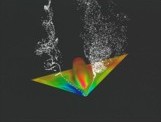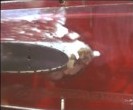|
Computational
Wave Dynamics©
 Physics
and Engineering today still uses almost entirely a Particle
Model of reality. The mathematical modelling of fluid
flows starts with an arbitrary "fluid particle" that
undergoes motion and deformation according to the "laws"
of Newtonian Mechanics. The so called Fundamental Equations
of Fluid Motion, the Navier Stokes Equations, were derived
in the first half of the Nineteenth Century. They still
form the foundation of fluid mechanics today. Physics
and Engineering today still uses almost entirely a Particle
Model of reality. The mathematical modelling of fluid
flows starts with an arbitrary "fluid particle" that
undergoes motion and deformation according to the "laws"
of Newtonian Mechanics. The so called Fundamental Equations
of Fluid Motion, the Navier Stokes Equations, were derived
in the first half of the Nineteenth Century. They still
form the foundation of fluid mechanics today.
Particles
vs. Waves
This
attachment to the Particular View is preventing progress
in many areas of Science and Engineering. It has been
known since the formulation of the Heisenberg Uncertainty
Principle and the development of Quantum Mechanics that
matter is not particulate but composed of the interference
patterns of electromagnetic wave fields.
If
one observes the most obvious body of fluid on the planet
- the Sea - the first thing one notices is that all
motion in and on the sea is of a wave nature.
Similarly,
all motion and disturbance of the atmosphere is also
of a wave nature - otherwise known as sound.
Even
in solids, all forces, stresses and strains are transmitted
by wave motion. Apparently solid matter can in fact
be considered to be composed of standing waves of ultrasound.
Therefore,
all mechanical interactions arise from the interference
of Electromagnetic Wave Fields.
In
order to reflect nature as accurately and efficiently
as possible in our engineering modelling and simulation
tools, we must develop systems that are based on this
fundamental reality - that all mechanical interactions
are fundamentally of a wave nature, not the "particular"
interactions of classical mechanics.
Digital
to Analogue Conversion
This
approach cannot be achieved with the now predominant
digital computer architecture.
The
reason for this is Chaos,
in particular Sensitive
Dependence on Initial Conditions - the "Butterfly
Effect".
Until the end of the 1960s, Analogue and Digital Computers
played an equal role in science and engineering. The
analogue computer is an inherently massively parallel
system that can solve many engineering problems in a
fraction of the time required by digital computers.
A digital computer on the other hand creates a numeric approximation and discretisation to
solve the relevant (partial) differential
equations. The iterative numerical methods used
to then solve the equations are themselves subject to
the Laws of Chaos, on top of the effects of Chaos on
the reality itself that we are trying to simulate.
In addition, the partial differential equations of fluid
flow are based on a fallacy - the particle model.
In
effect, our digital computer techniques are only useable
within regimes that have already been explored experimentally.
In short, they are useful for refining what lies within
known domains - they are not useful for real discovery.
The
Analogue Computational Model offers the potential to
directly simulate the underlying Wave Fields of matter
with a direct physical wave analogue, not an abstracted
"mathematical model" of those waves.
MIR
are working to develop an analogue computational system
that will allow 100% accurate predictive simulation
of fluid flow - or as near to 100% as the inherent uncertainty
of the nature of Chaos and Sensitive Dependence on Initial
Conditions allows.
We
call this Computational
Wave Dynamics.
 Real
Time Simulation Real
Time Simulation
This analogue computational model also promises to allow
real time simulation of any regime of fluid flow and
solid matter interactions - to replace CFD and Finite
Element Analysis. It will be a real Computational
Wind Tunnel.
Predictive Life Modelling
An
adjunct to this is a system for predictive modelling
and simulation of the future life, maintenance requirements
and reliability of engineering artifacts and their ongoing
in-service monitoring. This could ultimately be extended
to the medical diagnosis of living beings.
Further Information
For
more information on Computational Wave Dynamics you
can download the following introductory paper:
Observations on the Application of Chaos Theory to the Modelling of
Fluid Flows
|
